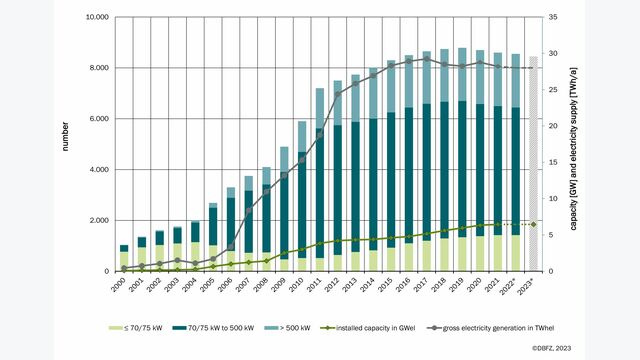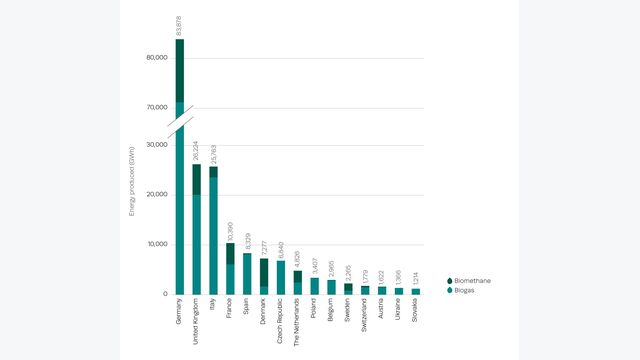Material and energetic use of biowaste : Biogas: An important contribution to climate and resource protection
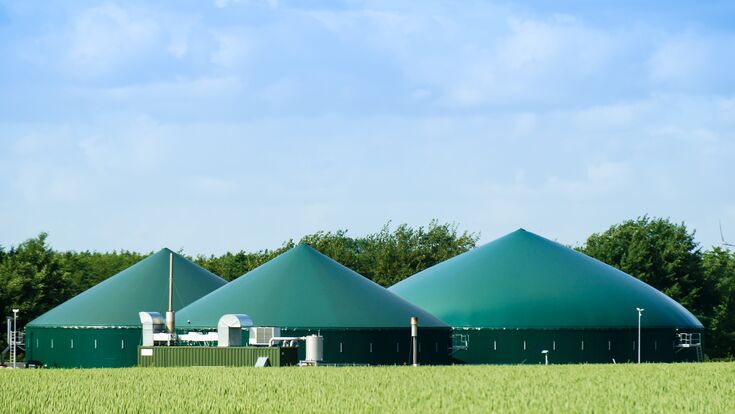
1. Introduction
The Department of Waste and Resource Management at the University of Rostock has been tackling engineering challenges concerning the waste management industry for 30 years, from reducing waste through recycling technologies to remediation. The focus of the department is on treating biogenic wastes and, geographically speaking, increasingly on international projects: the past 15 years have seen more and more projects in Europe, MENA (Middle East and North Africa), China, India and Africa. The DBFZ (Deutsches Biomasseforschungszentrum, German Biomass Research Centre) was founded in Leipzig in 2008 and has developed into the central federal research institute for the material and energetic use of biomass. One thematic focus is on the utilisation of biomass residues and wastes, which provides options for close collaboration with the University of Rostock. Michael Nelles has been Head of the Department of Waste and Resource Management since 2006 and Scientific Director of the DBFZ since 2012. Since 2018, he has been head of the ISWA Germany working group, which coordinates national ISWA activities, and he has also represented Germany as the national ISWA member since 2022.
Against this background, this contribution describes the current and future role of material and energetic uses of biogenic residues and wastes. The aspects of climate and resource protection are discussed, as are energy supply, bio- and circular economy, and developments in Germany and Europe, taking the biogas sector as an example. The information is based on a number of current publications [1, 2, 3, 4, 5], which are recommended for additional input.
Climate and resource protection are our key global challenges for the future. However, current results and trends do not look good at either national or international level. Since the 1970s, global consumption of resources (including energy) has exceeded the planet’s capability to regenerate these resources. In 2022, the environmental footprint was 75 per cent too high. This means 1.75 Earths would be required to regenerate the resources consumed. In Germany, the ratio is twice as high – which indicates that three Earths would be needed if everyone on the plant had our lifestyle. The USA is ranked last, at 5.1 Earths. On the other hand, the two most populous nations look somewhat (China at 2.4 Earths) or significantly (India, at 0.8 Earths) better [10].
Germany will only reach its goal of climate neutrality by 2045 if we radically lower our consumption of both materials and energy. This will require both significant increases in efficiency and sacrifices in consumption. Moreover, energy supply needs to shift entirely to renewable energy carriers over the next few decades. This will require a tremendous increase in installations and optimised integration of all renewables: wind, solar, bio- and geothermal energy and hydropower, as well as of all sectors: electricity, heating/cooling and transport. Furthermore, our ‘linear’ economic system must develop into a true circular economy. And last but not least, industry supply with organic raw materials must shift from petrochemical to biobased resources.
Put simply (see Fig. 1), this means we need to work along the following formula:
Climate-neutral society = renewable energies + circular economy
Over the past few years, Germany has created an ‘intergenerational contract for climate’, which provides the background for several legislative changes and tightened climate protection targets. The latter currently stipulate that Germany lower its greenhouse gas emissions by at least 65 per cent by 2030, and by 88 per cent by 2040 (both compared to 1990 figures). From 2045, the Federal Republic must be climate-neutral, and from 2050 onwards, fewer greenhouse gases should be emitted than can be fixed by natural means.
How does this compare to the status quo? In 2022, both the share of renewable energies in primary energy consumption and the share of waste-based secondary resources used in production were well below 20 per cent. The ‘Energiewende’ (energy turnaround) and ‘Rohstoffwende’ (raw material turnaround) stand at the end of a long road, while legislative targets are clear and the time to achieve them is getting short. Thus, Germany is not the forerunner it likes to see itself as, but is at global average. And this in turn indicates the enormous global task in front of us all on the path towards worldwide climate neutrality.
Like our content? Subscribe to our newsletters!
2. Using biogenic residues and wastes: contribution to climate and resource protection
Biomass is already is high demand today for food, feed, materials and energy (see Fig. 2). It is, therefore, a valuable and limited resource, and global demand is set to increase over the next 30 years at least, as it is the cornerstone of the current and future bioeconomy, which also includes all material and energetic uses of biobased residues and wastes. Energetic biomass usage will remain an integral part of a ‘future-proof’ global energy system. However, this will require us to produce biomass in a sustainable way and use it in the most efficient and environmentally as well as economically beneficial way possible. New technological concepts for co-production and cascading uses are needed as well as for negative emissions, which can be generated by storing ‘green’ carbon.
Optimising the material and energy usage of biogenic residues and wastes is therefore key to a sustainable bioeconomy.
Central national and international stakeholders, including DGAW, RETech, ISWA and IWWG, have already taken up this challenge. ISWA WG Biological Treatment of Waste, in particular, has made the topic a priority and makes a significant contribution to the sustainable use of biowaste at global level. In Germany, the Federal Government aims to finalise its National Biomass Strategy (NABIS) by the end of 2023. NABIS will also highlight the important role of material and energetic use of biogenic residues and wastes.
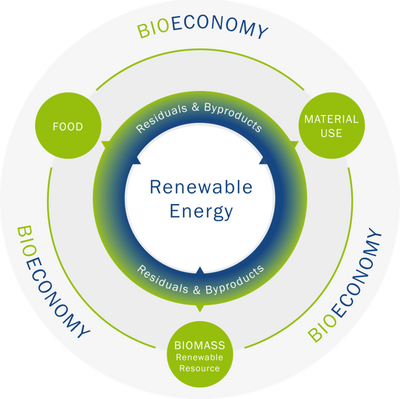
The technical potential of biogenic residues and wastes in Germany amounts to about 113 M tonnes of dry mass (DM). This comprises agricultural and forestry by-products, industrial and communal wastes and sewage sludges (DBFZ monitoring of biogenic residues; see Fig. 3). 74 per cent of this potential is already being used as material or energy, but usage may not always be efficient or make sense from a systemic viewpoint. DBFZ assumes that, on the one hand, current value chains could be optimised and, on the other, an additional amount of about 29 M tonnes DM could still be mobilised, of which around 23 M tonnes DM would be suitable for fermentation, i.e. for biogas/biomethane production. It must be noted here that, since figures are given in DM, the actual volumes are much higher. For instance, the 20 M tonnes DM of liquid and dry manure generated by animal husbandry in Germany per year equal about 138 M tonnes wet mass.
Bioenergy currently makes an important contribution to Germany’s energy mix. In 2022, it accounted for 9.9 per cent of total primary energy consumption. All other renewable energies (RE) together only made up 7.3 per cent (see Fig. 4). Despite significant decreases in energy consumption in 2022, the share of renewables in final energy consumption only increased from 19.2 to 20.4 per cent. Biomass is still the most important RE carrier in Germany and is in demand in all sectors: heating, transport and electricity [6]. In consequence, energetic biomass use saved about 74 M t CO2 eq – a large contribution to climate protection [6].
3. Biogas/biomethane in Germany and Europe
By the end of 2022, about 8,700 biogas plants were in operation in Germany. 98 per cent of these were agricultural plants with energy crops, e.g. corn, and residues such as liquid and solid animal manure as input substrates. 240 plants upgrade their biogas to biomethane. More than half of all plants are located in the three federal states of Lower Saxony, Bavaria and Baden-Wuerttemberg. Since 2012, the number of newly installed plants has not been significant. Any expansions mostly increase the capacity of existing plants, motivated by the so-called flexibility premium. This instrument gives an incentive to provide additional electric capacity via new and/or more powerful CHP for flexible, demand-oriented electricity production, and to sell any electricity produced directly on the market. The few new installed plants are either small (≤ 75 kWel), liquid manure-based or ferment bio-waste (see Fig. 5 and 6).
Figure 6: Development of biogas plants with on-site electricity production, sorted by size, gross electricity production and total biogas capacity installed. Class 70/75kW: up to 2012, ≤ 70 kW, from 2012, new liquid manure-based plants ≤ 75kW included
- © DBFZ database, BMWK 2022 *Forecast DBFZ 2022 and 2023, © DBFZ 2023By the end of 2022, 148 biowaste fermentation plants were in operation in Germany. These produce biogas from household biowaste, garden and park waste, food leftovers, waste from the food industry and other organic waste (organic share ≥ 90% of total mass). 123 of these plants produce electricity on-site, while the others upgrade the biogas to biomethane. Figure 7 depicts the geographical distribution of the plants that produce electricity, sorted by input substrate (data from 2021).
Since dedicated incentives were introduced for the fermentation of municipal biowastes by the Renewable Energy Act of 2012, about 40 plants of this kind have started operating in Germany, 30 of which produce electricity on-site and 10 biomethane. Other new plants use food, industrial or similar organic waste. The average capacity of plants which started operating from 2012 onwards is about 960 kWel. Roughly half of these plants act as upstream fermentative treatment prior to composting. By the end of 2022, just under 60 of these fermentation units with downstream composting were in operation.
Looking at the energy balance, agricultural residues and biogenic wastes only made up about 23 per cent (21 TWh) of input material for the 8,700 biogas plants, while 77 per cent (70 TWh) is provided by energy crops, especially corn. DABFZ estimates that an additional 17.5 TWh could be mobilised from biogenic residues and wastes in the short to medium term if suitable mobilisation strategies are implemented. Such a large, almost two-fold, increase would serve climate protection goals [7]. However, it must be emphasised that the contribution of residues and wastes to biogas/biomethane production must be increased significantly in order to guarantee their sustainable contribution to material and energy supply.
In future, biomethane and products from the biogas process will also be in demand in different industries as raw materials. Conventional biogas plants will therefore develop into biorefineries with multiple output products (see example in Fig. 9). A number of R&D projects in Germany are working on these processes, including at DBFZ and UFZ.
![© Nelles Figure 8: Estimate of biogas potentials that can be mobilised from residues and wastes [7]](/imager/media/wasteManagementWorld/3993666/Biogas-Nelles-Abbildung8_488989b8eeb1c45e9b1810f4a6741885.jpg)
With regard to electricity production, biogas plants should increasingly and quickly act as highly flexible power plants for peak demand. In this role, they have the highest systemic value for grid stabilisation. This is especially relevant in the current situation, as flexible operation of existing biogas plants could replace up to 22 per cent of fossil-gas based plants for demand peaks. According to DBFZ estimates, suitable measures could increase this to 46 per cent and thus provide a substantial contribution to security of supply [7].
Biomethane is also increasingly in demand as an advanced biofuel. Again, production should focus on residues and wastes as raw materials for sustainability reasons. One example of the DBFZ’s manifold R&D activities in this area is the BMDV-funded research and demonstration project ‘Pilot-SBG – bio-based resources and hydrogen to methane as fuel. Planning and realisation of a pilot plant’. The Pilot-SBG, short for ‘pilot plant synthesised biogas’, will convert currently under-utilised residues and wastes (straw and liquid manure from agriculture plus urban green and biowaste) to renewable methane as the main product. This methane could help to de-fossilise the transport sector. Construction of the pilot plant at the DBFZ will be complete by mid-2023. The individual modules will then serve as an R&D platform for industry and academia (see Fig. 10).
Compared to other European countries, Germany has put the highest number of biogas plants into operation over the past few years and produces the most energy in the sector by far. However, developments in Europe are very dynamic, and other countries will close the gap over the next few years, with fermentation of residues and wastes taking a prime role everywhere. Moreover, countries such as Denmark, France and the Netherlands have ambitious aims regarding upgrading to biomethane (see also Fig. 11).
4. Outlook
To sum up, the transformation into a climate-neutral society which is urgently required by mid-century can only be achieved if primarily the more developed countries radically reduce their consumption of materials and energy. This will require both efficiency increases and sacrifices in consumption.
Other necessary fields of action include the shift to renewable energies in all sectors, the development of a true circular economy instead of linear waste management, and the shift of industrial supply of organic raw materials from fossil to biobased resources. All of this is put simply in the formula ‘climate-neutral society = renewable energies + circular economy’.
An optimised material and energetic usage of biogenic residues and wastes is key to such a sustainable, biobased circular economy (bioeconomy) as well as to a 100 per cent renewable energy system. If implemented successfully, this will make a significant contribution to material and energy supply and thus to climate and resource protection. The residues and wastes that accrue globally have a high proportion of fermentable contents and could be converted very efficiently into methane, green CO2 and fertilisers from the digestate. Waste-based biogas plants will increasingly become biorefineries and as such serve the circular bioeconomy currently under development. The biogas sector is especially well developed in Germany and other European countries, but there is also dynamic development in Asia (especially China and India), the Americas, Africa and Australia. ISWA experts are in demand to accompany this development, and the DBFZ and University of Rostock are looking forward to cooperating on this.
Authors: Michael Nelles,1,2 Karen Deprie,2 Peter Kornatz,2 Gert Morscheck,1 Satya Narra1,2 and Abdallah Nassour1
1) University of Rostock, Department of Waste and Resource Management, 2) DBFZ (German Biomass Research Centre), Leipzig
Author contact:
Prof. Dr Michael Nelles
Head of Department of Waste and Resource Management, Faculty of Agricultural and Environmental Sciences, University of Rostock
Justus von Liebig Weg 6, 18051 Rostock, Germany
Phone: +49 (0) 381 498 3400, fax: +49 (0) 381 498 3402
E-mail: michael.nelles@uni-rostock.de
Web: www.auf.aw.uni-rostock.de
and
Scientific Managing Director of DBFZ (Deutsches Biomasseforschungszentrum gGmbH, German Biomass Research Centre)
Torgauer Str. 116, 04347 Leipzig, Germany
Phone: +49 (0) 3412434 112, fax: +49(0) 3412434 133
E-mail: Michael.nelles@dbfz.de
Web: www.dbfz.de
References
[1] Nelles, M., Angelova, E., Deprie, K., Görsch, K., Hartmann, I., Herklotz, B., Kornatz, P., Lenz, V., Müller-Langer, F., Naegeli de Torres, F., Narra, S., Rensberg, N., Schaller, S. and Thrän, D. (2022), “Smart Bioenergy – Die Rolle der energetischen Verwertung von biogenen Abfällen und Reststoffen bei der Transformation zu einer klimaneutralen Gesellschaft”, in proceedings of the 16th Rostocker Bioenergieforum 2022. ISBN: 978-3-86009-535-5.
[2] Nelles, M. and Deprie, K. (2022), “Stoffliche und energetische Verwertung biogener Rest- und Abfallstoffe als Beitrag zum Klimaschutz in Deutschland”, in Pomberger, R. et al. (ed.), Recy & Depotech 2022, conference transcript of the 16th Recy & DepoTech Conference, p. 495–500. ISBN: 978-3-200-08675-3.
[3] Nelles, M., Deprie, K. and Kornatz, P. (2023), “Biogene Abfälle und Reststoffe. Kohlenstoffquelle, Bioenergie und negative Emissionen”, in Müll und Abfall, vol. 55, issue 02/2023, p. 96–102. ISSN 0027-2957.
[4] Nassour, A., Morscheck, G., Narra, S., Sprafke, J., Gebauer, R., Antwi, E., Ekanthalu, V. S., Jalalipour, H., Hemidat, S., Wiechert, J., Chaher, N., Narra, M.-M. and Nelles, M. (2022), “Aktuelle Projekte der Universität Rostock: Beiträge auf dem Weg zu einer klimaneutralen Kreislaufwirtschaft”, in Müll und Abfall, vol. 54, issue 02/2022, p. 234–242. ISSN: 0027-2957.
[5] Nelles, M. (2022), “Multitalent Biomasse/Biogas – Beiträge zu Energieversorgung, Kreislaufwirtschaft sowie Klima- und Ressourcenschutz”, in Entsorga-Magazin: Das Fachmagazin für Kreislaufwirtschaft, vol. 42, issue June/July 2023 (in preparation). ISSN: 0933-3754.
[6] AGEE-Stat (2023), “Erneuerbare Energien in Deutschland. Daten zur Entwicklung im Jahr 2022.
Hintergrund // Februar 2023”. Geschäftsstelle der Arbeitsgruppe Erneuerbare Energien-Statistik (AGEE-Stat) am Umweltbundesamt, Umweltbundesamt (ed.), https://www.umweltbundesamt.de..., accessed 21.04.2023.
[7] Dotzauer, M., Barchmann, T. and Arnold, K. (2022), “Kurzstudie zur Rolle von Biogas für ein klimaneutrales, 100 % erneuerbares Stromsystem 2035 (KS_BSKES)”, DBFZ & Wuppertal-Institut, https://www.dbfz.de/fileadmin/..., accessed 21.04.2023.
[8] AGEB (Arbeitsgemeinschaft Energiebilanzen e.V.) (2022), “Energieverbrauch in Deutschland im Jahr 2021”, https://ag-energiebilanzen.de/, accessed 14.02.2022.
[9] EBA (2023), “EBA Statistical Report 2022 – Tracking biogas and biomethane deployment across
Europe”, Brussels, November 2022.
[10] Global Footprint Network (2023), “National Footprint and Biocapacity Accounts 2022 Edition”, https://data.footprintnetwork...., accessed 18.04.2023.
x


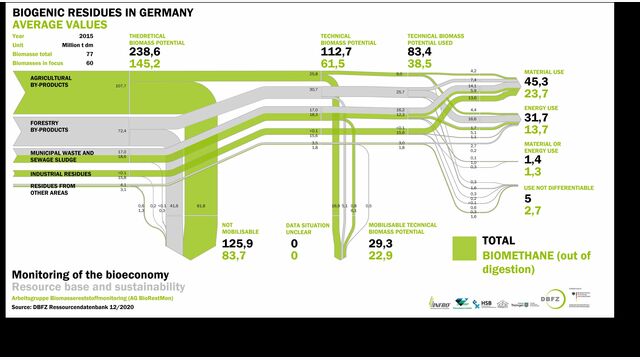
![© DBFZ 2023 Figure 4: Primary energy consumption in Germany, 2022, graphic by DBFZ based on [6], © DBFZ 2023](/imager/media/wasteManagementWorld/3993410/Biogas-Nelles-Abbildung4_e836ab76d05c8bfad90ac05325f1c4bf.jpg)

